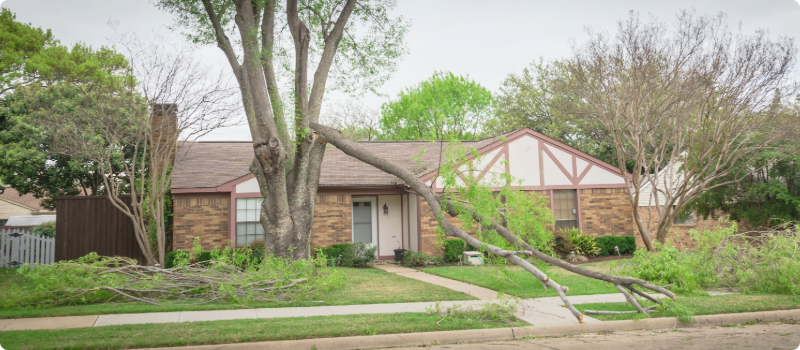What is windstorm insurance?
Updated June 3, 2024 . AmFam Team
Windstorm coverage is typically included in a standard homeowners policy. It’s protection that pays for the restoration or replacement of your home and your personal possessions if a wind event results in a covered loss on your property. But depending on where you live, such as designated coastal areas, you may need to purchase hurricane insurance separately in addition to your standard homeowners coverage.
Hurricane Insurance may be required if your home is located in specific coastal counties that are designated by each state. If your home is in one of those areas, this added coverage may be required by your insurance company. And if your location is prone to tornadoes, hail or other types of extreme weather events, you may find coverage for windstorms will cost you extra.

What does windstorm insurance cover?
Coverage for windstorms and hail helps pay the costs to repair or restore your home and property that have been damaged or destroyed from a qualifying weather event.
Windstorms can come in many varieties, from straight-line winds to derechos. Derechos are known as widespread, long-lived windstorms. They’re usually associated with bands of rapidly moving thunderstorms that have a “bow echo" on radar with high-wind squall lines as the front advances. In some cases, these high-wind events are not accompanied by any rain or precipitation.
Homes that are located too close to coastal areas may be excluded from windstorm coverage for specific designated hurricane events. So be sure to check with your agent and learn about whether your home needs specific hurricane coverage. If you are in one of these coastal areas, you may also want to purchase flood coverage for storm surges from FEMA. Most insurance companies are authorized to sell flood coverage through the Federal Flood Insurance Program.
Windstorm coverage has been limited historically in the following ways:
- Your car won’t typically be covered under your homeowners policy if a tree falls on it during a wind event — you’ll need a separate comprehensive auto policy for that
- Coverage may be limited to your home and the belongings within your home
- Policies may include coverage for other structures, swimming pools, garages and sheds — specific, additional coverage may be necessary
- You may have a limited period of days in which to file a claim after a qualifying covered loss — delays can compromise coverage
- Damages from storm surges to your home will not be covered
Hurricane coverage can differ by state so please check with your agent to learn about state-specific windstorm coverage requirements.

Understanding windstorm deductibles
Sometimes called a wind-hail deductible, windstorm deductibles are determined as a percentage of your home’s total insured value. You can find that figure on your insurance policy under the Coverage A section: the dwelling coverage limit.
So, if your home’s dwelling coverage is valued at $250,000, and your policy required a 1 percent deductible, you’d have to pay a $2,500 deductible before your claim would pay out. Take a look at your policy’s declarations page for details on what you’ll be required to pay.
Typically, paying a higher premium allows you to pay a lower deductible. For some, paying a higher deductible is a better fit because that usually means they’ll be paying a lower premium.
How can added diminishing deductible coverage help?
At American Family Insurance, we know that a deductible isn’t always the easiest thing to pay after the unexpected. But with our added Diminishing Deductible coverage, you may be able to reduce the amount due on your deductible. Here’s how it works:
For every year that you’ve purchased Diminishing Deductible coverage, and you don’t file a claim, your deductible will decrease by $100. Suppose that six years in, your home is hit by a covered windstorm event and your home’s roof is damaged. You’ll then be able to reduce your deductible by $600. It’s coverage that can really help to decrease your financial burden when filing a claim.

How much is windstorm insurance?
Many factors will be used when your insurance company calculates the cost of your premium and additional coverages. How much is wind and hail insurance? That all depends on several key factors used to calculate your premium.
The location of your home will be considered by your insurance company and so will your home’s size, value and age. And in coastal areas, insurance costs can increase — over the national average — due to the risk of high winds.
Other regions prone to tornadoes and frequent hail can also see higher premium costs due to those added risks. Certain areas may not qualify at all, especially when other conditions about your home exclude coverage, like an older home with outdated wiring.
It’s cases like these where optional homeowners coverages can really work together to help protect your home and your investments more completely. When wind damage coverage is paired with added matching siding coverage, you’ll be glad to know that your home’s curb appeal will be better preserved.
Check in with your American Family Insurance agent. Spend some time and learn about how your homeowners coverage and added policies can help you manage wind-related damage.
This information represents only a brief description of coverages, is not part of your policy, and is not a promise or guarantee of coverage. If there is any conflict between this information and your policy, the provisions of the policy will prevail. Insurance policy terms and conditions may apply. Exclusions may apply to policies, endorsements, or riders. Coverage may vary by state and may be subject to change. Some products are not available in every state. Please read your policy and contact your agent for assistance.
*Customers who bundle home and auto insurance policies may save up to 23% on both policies together (as of December 2023). Discounts may vary by state, property, policy form and company underwriting the home and/or auto policy. Discounts may not apply to all coverages on a home or auto policy.

